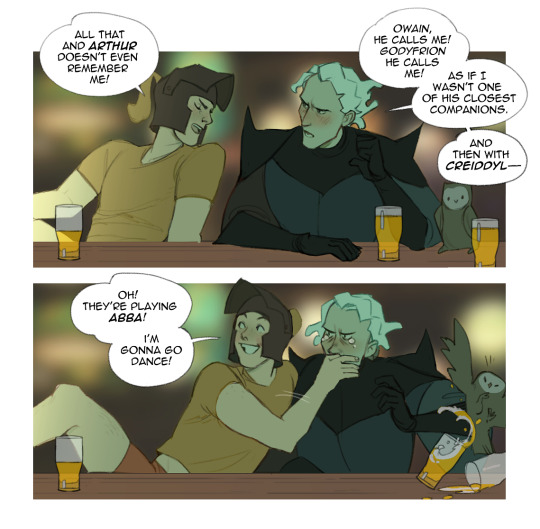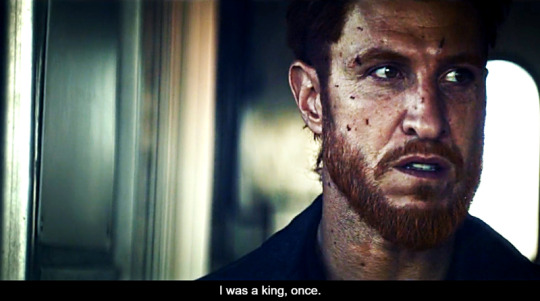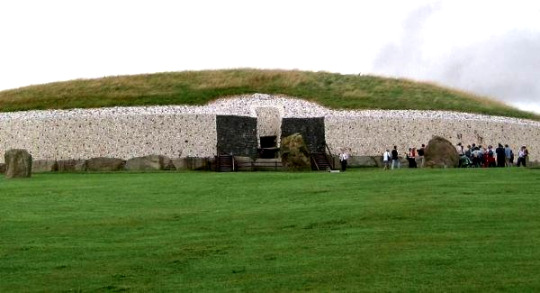#and there's the idea that annwn (of which gwyn ap nudd is the ruler) is itself underwater. and so on and so forth
Text

group therapy (they make each other worse)
#gwyn ap nudd#edern ap nudd#blodeuwedd#arthuriana#mabinogion#pa gur#medieval literature#welsh mythology#artists on tumblr#digital art#alcohol cw#art tag#------------------------------------------------------------#just as i don't think owain ap nudd exists i think gwyn godyfrion is gwyn ap gudd 😌#ok hear me out though#there are lots of gwyns in medieval welsh literature and i don't think they're all gwyn ap nudd (sadly)#but my man gwyn godyfrion. look. “dyfr” means water. like in the word dyfriog (watery). and gwyn ap nudd is very much associated with water#rides the watery horse du y moroedd. has a little chat with gwyddno garanhir who's the ruler of a kingdom that gets flooded.#dormach's funny flipper legs. rival gwythyr is associated with fire.#and there's the idea that annwn (of which gwyn ap nudd is the ruler) is itself underwater. and so on and so forth#sims-williams (‘the early welsh arthurian poems’ in arthur of the welsh. 1991) suggests godyfrion as a place name. underwater maybe.#so if gwyn godyfrion is “gwyn from under the water” i don't think it's unreasonable to suggest he's in some way connected to gwyn ap nudd#“but dizzy!! gwyn godyfrion is mentioned alongside gwyn ap nudd in culhwch and olwen!” the answer is that i simply choose to ignore that#while we're on the topic. the ddylad in creiddylad = flood#ok class dismissed#anyway gwyn and creiddylad i am pleased to tell you that my irl name means “sea” 😌 i am one of you
70 notes
·
View notes
Note
Hi !! In your post about "Mad Sweeney through the ages" you noted in the tags that you restrained yourself from going into tangents... I'm super interested about what you mentionned though ! Would you mind wiritng a little bit on the relationship between the Tuatha de and the fairies and the dead ?? Sorry, i'm very curious and I love history and mythology a lot !! (Also sorry for any mistakes, I'm not a native speaker !!) Thank you ! :)
Hello! Sorry it took me all day to answer this; it’s just that, well… this got a bit long, even though I tried to be brief. XD
Basically, what I was referring to is the same thing Sweeney talks about in the show: the way his identity has changed SIGNIFICANTLY over the centuries because the stories about him have mutated over time. People gradually conflated stories about certain types of beings (such as the Tuatha De Danann) with stories about other types of beings (such as fairies), or allowed elements of certain stories to influence others, and as a result, the very essence of what Sweeney IS evolved along with the folklore.

The cool thing, though — and I guess this is really the crux of what I was getting at in my tags — is that Sweeney’s particular evolutionary path isn’t a concept that’s unique to American Gods. I mean, to SOME extent, it’s AG’s invention; after all, the traditional figure of Mad Sweeney as portrayed in the Buile Suibhne is not a leprechaun or Lugh. He’s cursed, but he’s still just a mortal dude. But I think AG’s decision to MAKE him into those other things makes perfect sense in light of the fact that in certain areas that historically retained a strong Celtic influence (including much of the British Isles as well as Brittany), there really are a lot of intriguing similarities, overlaps, and parallels between the way folklore portrays fairies and the way it portrays the spirits of dead mortals. In Irish mythology specifically, the Tuatha De Danann get wrapped up in the relationship as well. These similarities have inspired a theory that elements of Celtic folklore about fairies might have evolved out of ancient superstitions about the dead and the places the dead were believed to inhabit. Which isn’t to say that it’s a direct evolution, nor that these three types of being are all exactly the same thing — simply that they seem to be related and to have influenced one another over time.
Unnecessarily detailed discussion under the cut, along with more of my thoughts on why I think this whole concept works out really well with regard to Mad Sweeney and lends a lot of weight to his backstory’s arc.
The People of the Mounds
One of the most familiar narratives in a classic fairy story is the human traveler who accidentally wanders into the fairy realm. It’s a story with innumerable variations. Perhaps the traveler simply follows the wrong path, or perhaps they enter a doorway in the side of a hill — either way, they end up in Faerie. It is a liminal space inhabited by beings that, because they are immortal or non-mortal, are not DEAD, exactly, but aren’t quite ALIVE, either, not in the way that mortal human beings are alive. And in many stories, it is also inhabited by dead humans. There are many versions of this story in which the traveler in Faerie is shocked to encounter a neighbor or loved one whom they know for a fact died years ago — like, actually physically DIED. And yet here their spirit is, trapped in this other world! The realm of Faerie is thus a place of great wonder, yes, but also great peril. It’s a place into which a person’s soul might be tragically stolen, though also a place from which they can sometimes be rescued. One such tale of rescue is the medieval poem Sir Orfeo, which is straight-up a Breton/English reimagining of Orpheus and Eurydice — except it’s set in Faerie instead of in the realm of the dead.
In short, Celtic stories often handle fairies and Faerie in a way that strongly evokes death, the realm of the dead, and the spirits of the dead. But for me, perhaps the most interesting aspect goes back to what I mentioned about WHERE these stories often take place. Where do the aos si dwell? Underground, of course — specifically, in hollow hills. It’s right there in the name: “aos si” means “people of the mounds.” Hence the stories in which a traveler enters Faerie through a door in the side of a hill. Coincidentally, where do the Tuatha de Danann dwell? Also underground — not originally, but they were driven underground by the Milesians, who took the above-ground world as their half of the earth in their truce.
But what kind of hill would be hollow? What kind of hill might have a doorway set into the side…?

Well… A hill like Newgrange, perhaps. Or like other hills within the Bru na Boinne complex. Or a hill like Bryn Celli Ddu in Wales, or Maes Howe in Orkney, or the Mound of the Hostages at Tara, or any number of other ancient barrows/tumuli: burial mounds built in prehistoric times as tombs for the human dead. Because the answer to “What other kind of creature dwells underground?” is, of course, dead people, at least in cultures which have tended to bury them.
Thus, the familiar trope of entering Faerie through a door in a hill very much evokes the idea of entering a tomb. This concept is reinforced by the fact that some specific fairy legends are anchored to specific tumuli. Newgrange is said to be the home of the Dagda and other Tuatha De; Cnoc Maedha is home to the fairy king Finvarra. Glastonbury Tor is associated with Gwyn ap Nudd of the Tylwyth Teg, ruler of the underworld of Annwn. Willy Howe is proposed to be the location of a specific version of one of those tales about a traveler wandering into a hill.
Not every fairy legend is associated with a specific hill, not every tumulus is associated with a fairy legend, and not every hill associated with a fairy legend has been confirmed to actually be a tomb. It’s more of a general association based on the tumulus shape. Also, some of these associations seem to have originated much later than others; they might be fairly recent inventions rather than old, traditional myths. But that’s kind of the point in AG, isn’t it: traditions evolve. Over time, they gather new associations and take on new meaning as the stories change. Did the idea that the aos si live in hollow hills evolve directly out of a superstition that specific hills — specific burial mounds — were home to the spirits of the dead? Perhaps! Perhaps not! Perhaps it’s more a case of stories mutually influencing each other, or maybe it’s convergent evolution, or maybe it’s sheer coincidence. But I think that the amount of similarity and overlap in these legends is enough to suggest roots in a common tradition, or at least to suggest that beliefs about these three categories of being have, over time, become intimately associated with each other.
Suibhne, the Dead King?
Which FINALLY brings us back to Sweeney.
I think the idea that the aos si evolved out of the Tuatha De Danann is pretty well known; I don’t think it’s entirely clear-cut from a historical standpoint, but it’s a theory I see mentioned quite often, and I feel like it intuitively makes sense. A transition from one supernatural, subterranean creature to another feels natural; it’s easy to grasp how those legends could be related. So it’s no surprise that American Gods would have a character who starts out as one of them and evolves into the other, especially since it’s been theorized that the concept of leprechauns in general might have evolved specifically out of Lugh. (The names share a possible etymology, and the characters share an association with luck.)
But the primary inspiration for Mad Sweeney — Suibhne, son of Colman Cuar, of the Buile Suibhne — feels, at first, like more of an outlier. Sure, Suibhne was under a curse, but he wasn’t, like, any type of supernatural creature… He was just a mortal human. The whole legend at least purports to be based on a real-life historical man. How does a mortal human get turned into a god or a fairy? How does that stage of Sweeney’s evolution fit in with leprechauns and Lugh?
To me, the key lies in the Annals of Tigernach. As I mentioned in my Mad Sweeney Through the Ages post, these annals record that Suibhne didn’t FLEE from the battle of Magh Rath… he DIED in it. And I don’t know whether AG is doing this on purpose, but in my opinion, this death really fits with the way AG has chosen to tell Suibhne’s story? In the Buile Suibhne, Suibhne flees the battlefield simply because the frenzy and St. Ronan’s curse overwhelm him. The idea that he fled because he foresaw his own death is AG’s own particular twist on the legend. AG’s Sweeney is a character who is haunted, throughout the different versions of himself, by near-deaths and foreseen-deaths and deaths that may or may not have actually happened. By choosing to reference the fact that Sweeney should have died at Magh Rath — possibly even did die at Magh Rath, heck, he supposedly died that night with the seer, too! — American Gods makes the critical decision to recast Suibhne mac Colmain as not merely the story of a king, but of a dead king.
And if you view the Buile Suibhne as the story of someone whose life, historically, ended at Magh Rath, but who through the power of mythology has been given an existence beyond Magh Rath, it becomes a story of undeath: of a mortal who becomes trapped in a strange, supernatural form of existence that is not exactly death but not really life as he knew it, either — sort of like a spirit trapped in Faerie. For me, AG’s decision to connect Suibhne’s legend with leprechauns and Lugh makes the most sense when I view Suibhne as a figure who kind of escaped death, but also kind of didn’t escape death, and always has this specter of death hanging over him for the rest of his cursed “life” after Magh Rath. If Suibhne is, essentially, a spirit persisting in a type of pseudo-life beyond death, then I can contextualize his role in Sweeney’s evolution within this whole theory of how the dead, the fae, and the Tuatha De Danann are intimately entwined.
Conclusion???
…WOW, this got long! Thanks for listening to me ramble. I hope it was interesting to you and that I’ve explained myself in a way that makes sense.
Obviously, I don’t know whether Gaiman / the showrunners of American Gods had any of these same concepts in mind when they were creating the book or the show. And I want to reiterate that the proposed relationship between these types of folklore is more of a theory than a concrete historical fact. It’s a theory that I find very compelling and very inspiring, but it’s difficult to really prove that traditional beliefs evolved in this way. Also, much of the actual scholarship I’ve found on this subject is older than I’d like, and I’m not sure whether different interpretations have since gained more traction in the field. Still, the work of Katharine Mary Briggs is a good place to start if you’re interested in reading more on this subject, especially her article “The Fairies and the Realms of the Dead.”
Regardless of whether it’s provable, though, I think it’s a theory that works beautifully with what we see in “Treasure of the Sun” and that fits really well with the mechanics of American Gods. And when it comes to AG, it doesn’t really matter, anyway, whether the dead and the fae and the gods were originally related or not — all that matters is that we humans believe that they are.
154 notes
·
View notes